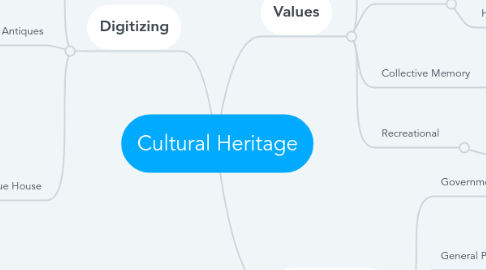
1. Digitizing
1.1. Intangible, e.g. Dragon Dance
1.1.1. Advantages
1.1.1.1. Practices or skills can be stored.
1.1.1.2. The activity can be reproduced without heir.
1.1.1.3. Loss due to insufficient heir would be minimized.
1.1.2. Disadvantages
1.1.2.1. Essence of skills may not be included
1.2. Movable, e.g. Antiques
1.2.1. Advantages
1.2.1.1. Objects can be recreated through 3D printing, and present in multiple places.
1.2.1.2. Objects can be presented in digital form, even though the real object is fragile.
1.2.2. Disadvantages
1.2.2.1. Fake products may be created, harming the intellectual properties.
1.3. Non-movable, Blue House
1.3.1. Advantages
1.3.1.1. Don't need to visit the site in person, reduce border constraint.
1.3.1.2. Original site can be closed for maintenance or archaeological activities.
1.3.2. Disadvantags
1.3.2.1. If the site can be accessed online, the original place may have less tourists, harming the local economy.
2. Values
2.1. Economic
2.1.1. Promote the local economy
2.1.1.1. E.g. Capital can be obtained through developing Tourism and government funding, which can be used to further preserve the Cultural Heritage later.
2.2. Education
2.2.1. The message behind
2.2.1.1. Promote the ideas behind the Cultural Heritage
2.2.1.1.1. E.g. The Cenotaph promotes the message of peace.
2.2.2. History
2.2.2.1. Promote the History of the site, to allow people learn the past
2.2.2.1.1. E.g. The History Museum of Hong Kong allows people to learn about the local History.
2.3. Collective Memory
2.3.1. Recall the past experience of the older generation
2.3.1.1. E.g. Former Japanese Navy Soldiers visited the National Naval Museum, recalling his memory during his service period in WWII.
2.4. Recreational
2.4.1. The younger generation may learn skills from their ancestors.
2.4.1.1. E.g. Elderly may have a chance to spend time with descendants, to teach them skills or tell them stories about the old times.
3. Stakeholders
3.1. Government
3.1.1. It has the duty to protect the exist Cultural Heritages, and maintain the balance between its accessibility and sustainability, through legislation and authority.
3.2. General Public
3.2.1. Every citizen has the right to access the information of the Cultural Heritages, they also have the duty to respect and not to damage the Cultural Heritages.
3.3. GLAMs
3.3.1. They have the duty to preserve the Cultural Heritages well, and keep it accessible by the general public.
3.4. Owners
3.4.1. They have the right to defend the intellectual properties of the Cultural Heritages, and also the responsibility to pass the knowledge to the younger generation.

